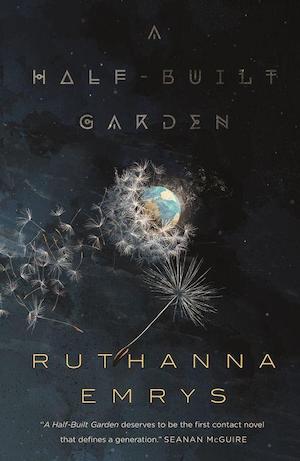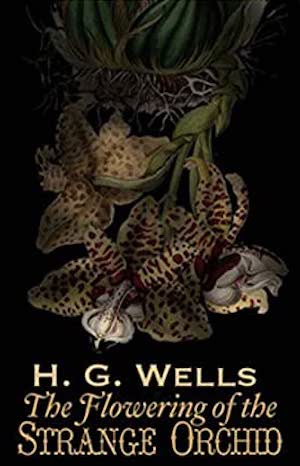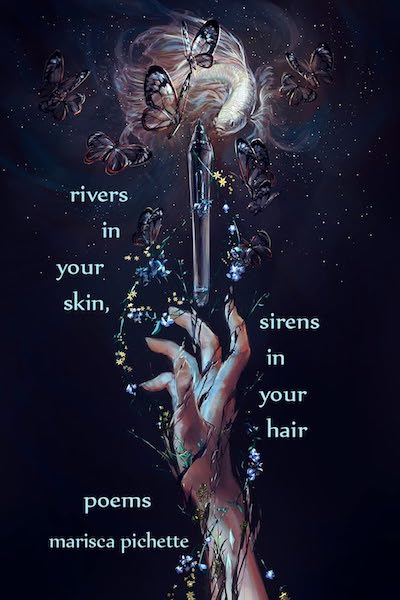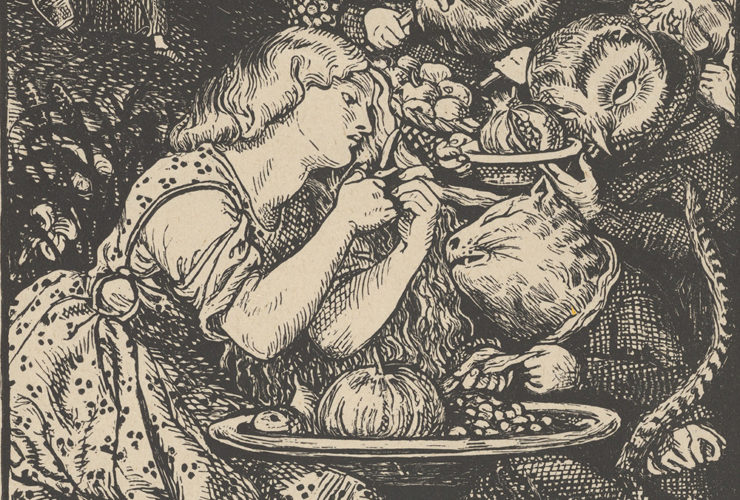Welcome back to Reading the Weird, in which we get girl cooties all over weird fiction, cosmic horror, and Lovecraftiana—from its historical roots through its most recent branches.
This week, we cover H.G. Wells’ “The Flowering of the Strange Orchid,” first published in the Pall Mall Budget in August 1894. Spoilers ahead!
“She had seen the plant once again, and the aerial rootlets, which were now some of them more than a foot long, had unfortunately reminded her of tentacles reaching out after something; and they got into her dreams, growing after her with incredible rapidity.”
Mr. Winter Wedderburn is a “shy, lonely, rather ineffectual man” with an income just sufficient to “keep off the spur of necessity.” He lives near London with a distant cousin who serves as his housekeeper. Nothing has ever happened to him, from childhood to his current age of fifty-six. To pass the time, he collects orchids. His greatest excitement is the auctions. You might buy a “brown shriveled lump of tissue” that dies on you, or that proves to be worth only what you paid for it—or that grows into a species previously unknown!
One morning he announces to his cousin an odd fancy that something will happen to him that day. Nothing dire—there’s to be an auction of orchids from the Andamans and the Indies, at which he might “buy something good unawares.” Batten, the orchids’ collector, was a man to whom so many exciting things happened! He was married twice, divorced once. Had malaria four times. Broke his thigh. Wounded by a poison-dart. And in the end jungle leeches drained him dry. A troublesome life, but it must have been very interesting. Except for the leeches.
The housekeeper sniffs: such excitements can hardly be healthy.
At the auction Wedderburn buys several rhizomes, which he proudly displays to his cousin. He feels sure some must be remarkable: maybe this unidentified one, the last poor Batten ever collected. In fact, they found it under his body in the mangrove swamp.
Its morbid history aside, the housekeeper particularly dislikes Batten’s final find, an ugly lump with protruding bits that reminds her of “a spider shamming dead.” Undeterred by her aversion, Wedderburn pots the “spider” along with his other purchases. The next few days he has a “wonderfully eventful time” fussing in his little hothouse.
The “spider” begins to grow. Wedderburn drags his cousin to view its promising aerial rootlets. She thinks they look like “little white fingers…trying to get at you,” while Wedderburn hopes that he indeed has a new species in hand. Perhaps it will even be one of those peculiar orchids with flowers no known insect can fertilize. Such plants reproduce by runners and such-like outgrowths, begging the question of what purpose their flowers can possibly serve.
The strange orchid’s aerial roots grow to resemble tentacles. The leaves are unusual for the deep red spots towards their bases. Wedderburn spends hours meditating on the approaching flowering, while his cousin dreams of the tentacles chasing her. At last Wedderburn enters the hothouse and smells a new odor, intensely rich and sweet. It emanates from the strange orchid’s just-opened blossom, white streaked with golden orange, the orange mixed with bluish-purple on the intricate coil of the labellum. This is not only a new species, but a new genus!
Buy the Book


A Half-Built Garden
His exultation gives way to a sense of how insufferable the orchid’s scent is, how hot the steamy air. As Wedderburn moves to check the thermometer, he’s overcome and collapses.
When he doesn’t appear for afternoon tea, his cousin looks for him in the hothouse. An intense perfume is the first thing she notices, followed by the shocking sight of Wedderburn lying face-upward beneath the strange orchid. More shocking is how the rootlets have extended a tight-stretched tangle to fasten on his chin, neck and hands. From under one tentacle trickles a thread of blood.
The cousin attacks the leech-like rootlets. Two snap and drip red sap. The scent of the flowers begins to overwhelm her, but she dares not faint. She opens the nearest door and smashes windows to let in untainted air. Strength renewed, she drags Wedderburn and the still-clinging orchid from the hothouse and tears off the suckers one by one. She sends an amazed odd-job man for water, then for the doctor. Wedderburn, white and bleeding from the circular marks left by the tentacles, opens his eyes and asks after the orchid. His cousin tells him she’ll deal with that.
Though he’s lost a lot of blood, Wedderburn will eventually revive. Not so the strange orchid, which is already withering by the time the doctor goes to check on the housekeeper’s fantastic story. Seeing how an aerial rootlet continues to twitch, he doesn’t examine the plant too closely. Next morning the orchid is black and putrescent, while the other orchids in the smashed hothouse have also shrivelled.
Up in his bedroom, however, Wedderburn is “bright and garrulous… in the glory of his strange adventure.”
What’s Cyclopean: If you discover a new species of orchid in your auction haul (never mind either the people who’ve known about it for generations or the actual guy who picked it), you could name it “Johnsmithia!”
The Degenerate Dutch: Wedderburn’s housekeeper cousin doesn’t think much of the Andaman Islanders, not that she’s ever met one—“the most disgusting wretches” and with no training in nursing besides.
Weirdbuilding: Vampirism and tentacles and exotic plants—all scary on their own, and better together!
Libronomicon: Bookbinding, as Wells suggests (and Lovecraft and Margaret Irwin know) can be just as dangerous a hobby as plant collecting.
Madness Takes Its Toll: Special interests (which Wedderburn’s plant obsession recognizably is) don’t count as madness, even if they do occasionally bite.
Anne’s Commentary
Let’s face it: Plants are not like us animals. They aren’t even in the same biological kingdom. Plantae, they call themselves, an innocently obvious designation that once included the algae and fungi, but then the plants got full of themselves and kicked out some of the less chic algae and all the fungi, however delicious. Plants pretend to be harmless, like, oh we can’t even move, so how could we ever endanger you divinely mobile creatures? They do move, though. Sneakily. Plants have no honor. In the end, they’re going to eat us. Sure, maybe it’s an animal that eats us first, but then the animal converts us into manure, and the plants belly up to the table. Uh, stem up to the table?
Never mind the exact analog between animal bellies and plant whatevers. The plant analog for animal naughty-bits are flowers, which plants flaunt with the utmost gaudiness, and among the most shameless of plants vis a vis their blossoms are the orchids.
Just before prom season, my favorite high school biology teacher liked to inform his classes that the word orchid is derived from the Greek orchis, meaning testicle. How fitting was it, then, for a lot of guys to pin floral nad-sacks on their dates? Tastefully color-coordinated with the date’s gown, of course, as if that made it all right to go so public with the sexual innuendo. Supposedly the ancient Greeks thought orchid rhizomes resembled testicles and so considered the plant emblematic of virility. Supposedly a Greek woman could eat large orchid rhizomes to ensure her unborn baby was a boy. Or was it the Greek father-to-be who had to eat large orchid rhizomes?
What does it mean, then, that mild-mannered Winter Wedderburn was so avid a collector of orchids? Dare we suppose he was trying to grow himself a pair? Multiple pairs! A whole hothouse full! Always looking for the rhizome that will make something happen for him, to him, the way things happen to his friend Harvey, the way things superlatively happened to the manly orchid-collector Batten. What does finally happen to Wedderburn is his ravishment by the orchid he prizes most, perhaps for him the consummation devoutly to be wished, however deadly. Luckily his cousin (chaperone-like) rescues him from the ravisher, so that he can afterwards glory in his—deflowering?
It should have served as a warning to Wedderburn that Batten didn’t survive collecting the Strange Orchid. His cousin, the oddly never-named heroine of the story, has a far keener danger-radar. What initially comes across as generalized paranoia and spinsterish overdelicacy turns out to be an absolutely accurate aversion where the Orchid’s concerned. Its rhizome is a spider shamming dead. Its aerial rootlets are grasping fingers and hunting tentacles: metaphors expressing intuited peril.
What doggedly rational Wedderburn intuits about the Orchid is that it might be one of those vegetatively-reproducing species in which the flower cannot be pollinated, cannot bear seeds. It is therefore no sexual organ. Its purpose is cryptic.
Its purpose, as we learn at story crisis, is to attract prey with luscious fragrance; that enticing emission then doubles as a knockout gas to render the prey helpless for the aerial rootlets which are in effect rasping mouths on long gullets. Blood, I presume, is what would provide this orchid with the energy to generate off-shoots. The flowers, then, do have a reproductive purpose, though a sterile one. A quibble: Where the hell does the strange orchid store an adult human’s entire blood volume? Wedderburn’s said to have lost a lot of blood, but the orchid’s not said to have visibly swollen. In Batten’s case, I guess it could have routed all his blood to its underground rhizome, where his too-late rescuers didn’t notice it. I bet the Andaman islanders knew about these vampiric orchids, though. Maybe, weary of Batten’s bravado, they even directed him into that mangrove swamp. Maybe they collected the strange orchid that did him in so that more of these tiresome collectors would pay a mortal price for their botanical plundering….
There are carnivorous plants, but orchids aren’t known to be among them (with the possible exception of Venezuela’s Aracamunia liesneri.) What if Wedderburn’s mystery orchid is no orchid at all, but an orchid-mimic evolved to prey on orchidophiles and orchidologists?
I told you plants are sneaky! Unless the orchid-mimic is actually an animal, in which case its behavior is fine and fair. What’s not fair, again, is that the ultimately kickass cousin-housekeeper doesn’t get a name while the generic doctor who’s afraid to touch a twitching moribund rootlet does.
What’s up with that, H. G.?
Ruthanna’s Commentary
Well, here’s one that belongs in Rappaccini’s garden. Or maybe in the plant store right next to Wo and Shade, Importers. There seems to be a lot of anxiety in these stories about single men with weird hobbies. Wonder why that could be…
Coincidentally, I just listened to a 99% Invisible episode on houseplant fads, including the Victorian obsession with exotic flora that provides the backdrop for Wells. (The other two were the current wave of succulent-focused TikToks, and 70s Earth Mama plant-whisperers. The latter does explain the number of spider plants in my childhood home!) Wedderburn’s hobby is a way of bringing the British Empire home. Even people to whom “nothing ever happens,” people who would never actually traipse through swamps surrounded by trusty natives, can exploit those natives to keep the one in a thousand plants that survive the trip in a well-controlled tropical climate.
H. G. Wells was not known for being a good little imperialist.
Given Wells’ tendency toward egalitarianism, it strikes me as probably not a plot hole that Batten, the bloodsucking orchid’s “discoverer,” is not rescued by his companion Andaman Islanders—wretches and terrible nurses besides! Nor that the Islanders, presumably familiar with the plants in their own jungle, retain and pass the deadly orchid on to the rest of the British expedition. Having neglectfully let it wither into a state in which it happens to be perfectly safe to pass.
Scary brown people always know more about weirdness than civilized white folks. That doesn’t mean they’ll always provide convenient exposition. Why should they?
Fortunately for Wedderburn, Wells doesn’t take this social commentary to its logical conclusion, and lets the cousin be quick on the uptake. After a quick rescue and a little fresh air, Wedderburn’s back to normal and indeed quite pleased with his adventure. Almost get sucked dry by a carnivorous plant, and you’ll always have something to tell your friends down at the pub. Someone should explain that plus-side to Seymour Krelborn.
As with many bad-idea floral purchases, I’m left intrigued by the biology. There’s plenty of precedent for orchids getting their energy from something other than photosynthesis. And there’s plenty of precedent for carnivorous plants. Why not combine the two? Furthermore, orchids are well-skilled at attracting necessary animals, both visually and via scent. Admittedly, that’s normally pollinators, but there’s no reason that one couldn’t aim toward the appearance of flesh instead, and toward a smell that both attracts mammals and renders them docile for convenient feeding. Totally natural. Scarcely creepy at all, once you’ve learned what part of the forest to avoid. Potentially a boon for medicine, with enough dilution of that high-quality anesthetic.
Now go one step further, and you could get an orchid that feeds on human flesh and has a symbiotic relationship with fungus. Say, a cordyceps. At that point, Wedderburn becomes much more dangerous company. And Wells’ quick dose of creep gets much more disturbing.
Next week, we continue N. K. Jemisin’s The City We Became with Chapter 5: The Quest for Queens. Also and unrelatedly, Ruthanna has a book coming out on Tuesday!
Ruthanna Emrys’s A Half-Built Garden comes out July 26th. She is also the author of the Innsmouth Legacy series, including Winter Tide and Deep Roots. You can find some of her fiction, weird and otherwise, on Tor.com, most recently “The Word of Flesh and Soul.” Ruthanna is online on Twitter and Patreon, and offline in a mysterious manor house with her large, chaotic, multi-species household outside Washington DC.
Anne M. Pillsworth’s short story “The Madonna of the Abattoir” appears on Tor.com. Her young adult Mythos novel, Summoned, is available from Tor Teen along with sequel Fathomless. She lives in Edgewood, a Victorian trolley car suburb of Providence, Rhode Island, uncomfortably near Joseph Curwen’s underground laboratory.













